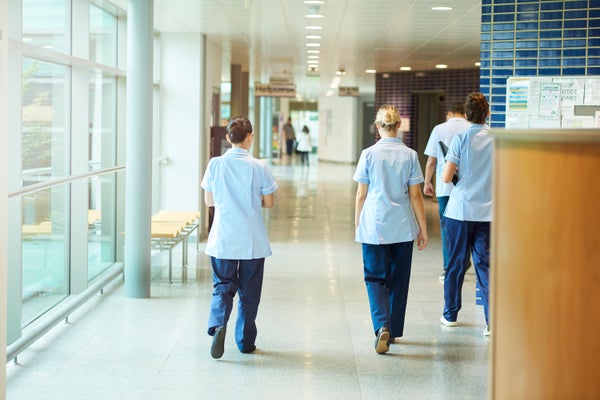This article was published in Scientific American’s former blog network and reflects the views of the author, not necessarily those of Scientific American
With COVID-19 cases already numbering in the thousands and a doubling rate of three days, the United States is on track to have 100 million cases by May. To have any hope of mitigating spread, we now know that we need to practice aggressive social distancing. As a medical student who was scheduled to have patient practicum experiences in the hospital in the coming month, therefore, I am concerned that many medical schools still have not pulled their students from clinical rotations.
A friend at one of these schools tells me that his supervisors keep asking him why he’s there and sending him home as early as possible. It wasn’t until this week that clinical rotations were temporarily suspended at my institution, despite the fact that the Bay Area is a COVID-19 hotspot alongside New York City and Seattle. It’s especially important for schools located in areas with less aggressive COVID-19 spread to seize the opportunity to take preemptive action.
Medical students are nonessential to the care team given that we must operate under supervision and lack the experience needed to inform clinical decision-making. Much of the unique value that we do bring lies in being able to spend more time getting to know patients than can our busy residents and attendings—which, in the context of a pandemic, is a perfect scenario for vector transmission. Since medical students frequently rotate from one clinical site to another, we pose the risk of rapidly spreading COVID-19 in our communities. We also consume depleted resources such as personal protective equipment.
On supporting science journalism
If you're enjoying this article, consider supporting our award-winning journalism by subscribing. By purchasing a subscription you are helping to ensure the future of impactful stories about the discoveries and ideas shaping our world today.
Recently, four medical students at Dartmouth were exposed to COVID-19. A student at the University of Mississippi Medical Center tested positive after returning from out-of-state travel. At Wits University in South Africa, an asymptomatic medical student tested positive, resulting in 350 contacts at the medical school being asked to go into self-isolation.
Data from South Korea, which has administered COVID-19 testing broadly across its population, found that almost 30 percent of 20–29-year-olds tested positive. Most medical students are in our 20s. Belonging to that demographic makes it likely that we will be among the 80 percent of COVID-19 cases that experience mild-to-moderate illness or are asymptomatic. It also means that we may unknowingly infect others. On average, a COVID-19 carrier passes the virus on to at least two other people. Limited access to testing means that we do not have a reliable way of being screened.
Hospitalized patients are uniquely vulnerable. The case fatality rate of COVID-19 is not only higher in the elderly, but also in those with chronic conditions such as cardiovascular disease. Even if medical students are kept from interacting directly with COVID-19 patients, we may contract and pass on the virus to other patients.
Keeping us away is also necessary to protect the hospital staff who are putting their lives at risk to keep our society afloat in this public health crisis. Over 3,000 health care workers have been infected in China and at least 22 have died. Those who don’t become critically ill are still taken out of commission while they are infectious, which we absolutely can’t afford with the mounting health burden of COVID-19.
Guidance from the Association of American Medical Colleges has been updated to endorse temporary suspension of clinical rotations but states that it is ultimately the decision of each individual school. It also leaves uncertainty regarding whether or not student graduation requirements will be affected.
Alternatives are possible to allow student education to continue without physical presence. Institutions are developing modules and simulations that can be completed remotely. Furthermore, telehealth infrastructure can be leveraged to enable students to help triage patients. With remote access to the electronic medical record, we can write up medical notes.
Outside of the clinical setting, there are many ways for us to recognize and address the needs of our communities without endangering them. Medical students at Washington University School of Medicine in St. Louis created a document to synthesize existing and emerging research evidence about COVID-19 to help doctors stay up-to-date. Medical students at Western University in Ontario launched community initiatives such as dropping off groceries outside the homes of those who are quarantined. Others are lobbying state and federal representatives, donating blood, and more.
This is a deeply frustrating situation for everyone involved. Our faculty want to ensure that the quality of our education isn’t compromised. We as students want to be able to participate in the care of patients, especially in a time when so many desperately need it. Many of us know people who are on the front lines. I fear for my brother, sister-in-law, friends and mentors who are giving everything they have to save patient lives.
But these concerns are superseded by the realities of the crisis we find ourselves in. Medical schools have a responsibility to protect trainees, patients and health care workers by pulling medical students from hospitals. And, as medical students, we need to acknowledge our limitations and find the ways in which we are best suited to help—for the sake of the communities that we swore an oath to serve.
Read more about the coronavirus outbreak here.
